#also functions as system diary
Explore tagged Tumblr posts
Text
something's waiting in the bushes of love: thominewt edition

#safe haven? alternate universe?#also functions as system diary#the ivy trio has doubled the size of our system overnight 😂 and#we've been having#a lott of fun#art from my heart#thominewt#maze runner#maze runner fanart#tmr fanart#tmr art#maze runner art#thomas tmr#minho tmr#newt tmr
3 notes
·
View notes
Text
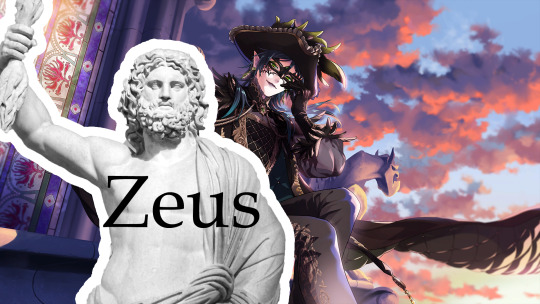
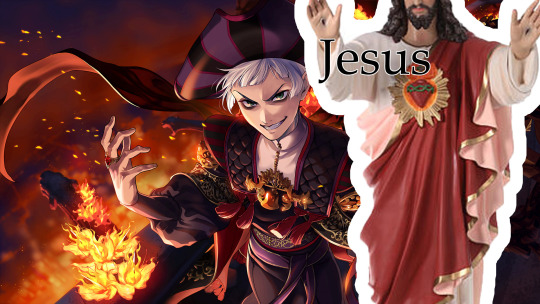
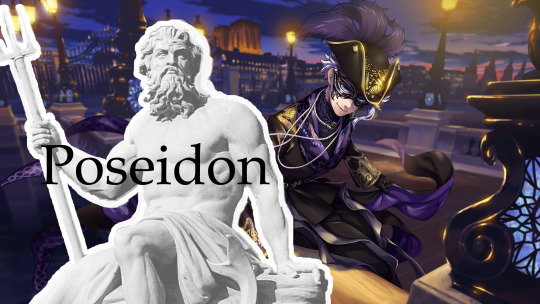
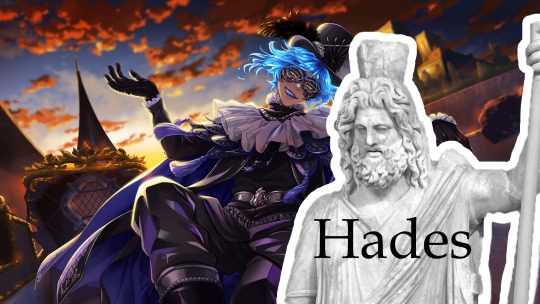
Nobody: Me at 3 AM: Glorious Masquerade represents the confrontation between polytheistic and monotheistic worldviews
Or "The Big Three of Olympus vs One Christian God" in the Glorious Masquerade event
Content Warning: Greek Mythology, religion, Christianity, Glorious Masquerade event spoilers
Note: I talk about things in this post from a researcher's point of view, in a descriptive and comparative manner mostly. Just some observations.
I've already discussed a similar concept before - Idia, Jade, and Sebek representing Hades, Poseidon, and Zeus, the "Big Three" in Greek mythology, the most powerful and important gods of Olympus - during the Harveston event. See the post here.
However, in the Glorious Masquerade, the situation becomes even more peculiar because the SSR characters are dorm leaders - those who are in charge. And then there's Rollo, who is twisted from Frollo.
Note: I will consider all sources of inspiration for Rollo, including the book and the musical, which were confirmed by Yana herself to be inspirations for Rollo.
What? Why? Who?
3 vs 1. The Big Three of Greek Pantheon vs The One God, who embodies 3 in 1 - the Father, the Son and the Spirit.
The Big Three are the three most powerful gods among the Olympians - Zeus, Poseidon and Hades.
Zeus commands the sky, lightning, kingship and summon any weather conditions.
Poseidon manipulates water, storms and earthquakes.
Hades has dominion over the dead and undead, darkness, earth-related disasters, and metals and jewels.
*By the way, lightning was considered just Zeus throwing a temper tantrum, and what happened when Malleus got angry? Right, he started throwing lightnings left and right.
And now we have Rollo. Twisted from Frollo, who, as we know was a religious man (especially in the book where he is a priest, not a minister).
And despite there being other characters, such as vice-president and the assistant, they aren't "real" or “important” characters like Rollo.
So we can say there is only one (1) main character in this event.
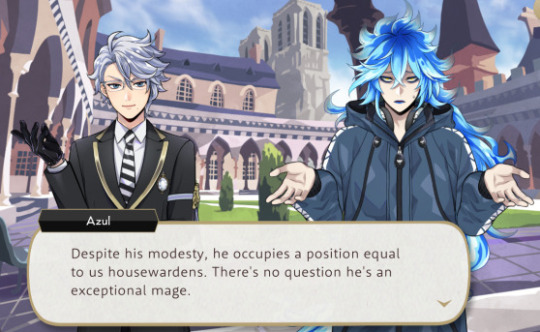
2. 7 Dorm Leaders vs 1 Head of the Council
As is well known, Ancient Greek mythology features many major gods, each controlling different aspects of life (or representing them, or serving as patrons). This makes Ancient Greek religion a polytheistic system - meaning it has multiple gods - akin to the Great Seven and the dorm system at NRC.
The Dorm Leader Council functions much like a small pantheon. Not to mention NRC is located on upper hills, which resembles a mountain (Olympus) if we look at the landscape of the Sage Island.
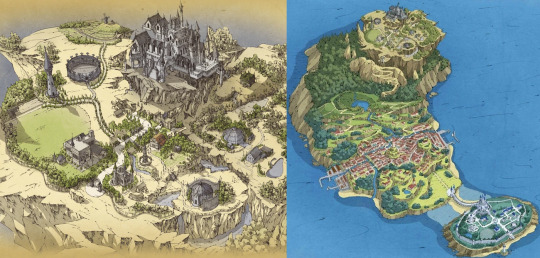
On the other hand, Christianity only has one God, making it monotheistic religion. There are multiple saints in Christianity, who are patrons of different aspects of life, however it is important to note that these saints do not control - they are more like the intercessors between man and God.
Even the NBC itself is focused on one Villain and has one statue in the yard, not the 7 (the "pantheon" of NRC). And NBC itself doesn't have Dorm system like NRC.
3. Oral vs Written
Greek religious tradition is primarily oral, with legends and stories passed down through generations by word of mouth.

In contrast, Christianity is predominantly a written religion, where the written canon holds great importance.
How is it important here?
Well, in this event specifically the NRC guys spend their time walking around and commenting on things. We learn some of their lore and thoughts on various topics through dialogue. Even Professor Trein reveals his past verbally telling about it. Naturally, it’s a game mechanism. But since we’re talking about such details….
On the other hand, the most important part of Rollo lore is found by the Big Three in written form - Rollo’s diary. It's also noted how Rollo prefers writing above all else. He writes in his diary, sends letters, and drafts invitations. While this may not apply to the NBC in general, since we're focusing on Rollo, this detail is worth considering as well.
4. Our guys vs That One
Another difference between the two religions is that the Greek gods had flaws that made them more similar to humans. They had tempers and they often held grudges. This made the followers of the religion not want to be like them but, instead learn from them and their shortcomings, frequently through fear.
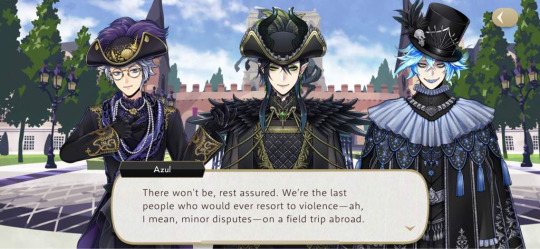
In contrast to the flawed gods of Greek mythology, Jesus is portrayed as a man who is to be aspired to, more so than the Greek portrayal of a god; who the audience learns from (imitating in a way), rather than obeys.

Our NRC boys are someone we know and who we’re familiar with. We know their struggles and fears, their dark past. Even the guys in charge of each dorm - the Dorm Leaders - are not so distant from the regular students. Well, more of less.
Whereas Rollo is described by all the characters we’ve met at NBC (and even from his vignette) as someone who is amazing, excellent, wonderful and so…exemplementry. Rollo, at the same time, distances himself from everyone.
5. Vertical vs Horizontal
A small but interesting observation is that many monotheistic religions, including Christianity, often have a “vertical mindset” - symbolizing a relationship between the human and God.
In Christian cosmology, we often imagine a vertical world structure: Hell at the bottom, the human realm in the middle, and Heaven above.
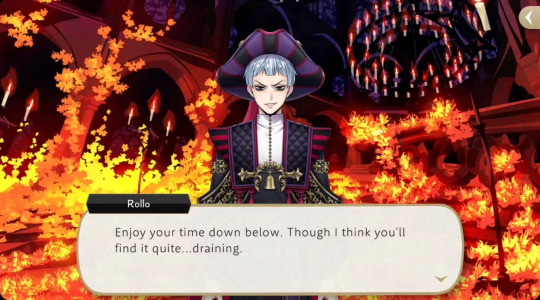
In this event, we also experience vertical movement when things get serious. Initially, when it's peaceful and fun, we mostly walk around the town (mostly horizontal, not including the lower parts).
However, when the action begins, Rollo first sends us downward into the sewers. From there, we start moving upward. The ascent of the tower is highly symbolic, as we are literally ascending towards the sky where Rollo awaits us (with his “judgment”)
6. Masks
The whole masquerade theme is, of course, a nod to the cartoon and part of the game feature to get the characters to dress up.
But let’s remember that in Ancient Greece, masks played a significant role in theater, particularly in tragedies and comedies (twst features elements of both). In general, it is known that masks represent hidden nature, transformation, and more.
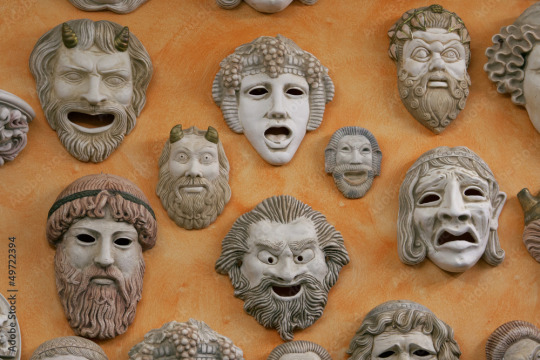
Interestingly, only our NRC squad wears masks and costumes. We even encountered some Royal Sword Academy students, but they were not given costumes (again, a game feature, but still noteworthy).
On the other hand, there's Rollo, who isn't wearing a mask or even a costume. He doesn’t need to. He is who he is, with no need to transform into something else, as he represents the One, in our comparison here.
What's even more interesting is that, despite not wearing a physical mask, Rollo is the one with ulterior motives in this event, and we only learn his true face later on. He metaphorically takes the mask off, even though he never wore one in the literal sense.
7. Catholic Guilt
The last but not least - Rollo's punishment, which, perhaps is the most fitting and cruel outcome for him. Rollo, after being defeated, expects harsh punishment because he is ruthless with himself and assumes others will treat him the same way. He failed and he expects to be punished. However our Big Three surprise him by concealing the truth and allowing others (the NBC mobs were the first to thank him for his bravery at the tower) to believe that Rollo was a hero. This situation forces Rollo into a state of internal torment, where he must live with the guilt of his actions while being praised for something he didn't truly do.
Rollo's punishment is psychological, forcing him to confront his guilt and shame in isolation. They choose leave him one on one with his Sin.
On the contrast, in Ancient Greek mythology punishments were often cruel and involved physical pain. One of the most popular example would be of course the myth about Prometheus, which, by the way involved Zeus.
And the way Big Three dealt with Rollo was truly cruel in its own way.


(from an interesting article about Greek Gods and punishment - here)

Fin
I left out some obvious notes like Malleus having horns, Rollo hating on magic etc.
Naturally, there may be other details I haven’t mentioned, so feel free to add any additional insights!
#the semester has just started but I'm already in the mood#was fighting the urge to add Comedia dell'Arte masks here#twisted wonderland#twst analysis#glorious masquerade#disney twisted wonderland#rollo flamme#malleus draconia#idia shroud#azul ashengrotto#twst spoilers#tw religion
195 notes
·
View notes
Text
Friend Like Me: Murderbot's Relationships With Other AIs throughout The Murderbot Diaries
It’s important to me that the thematic core of The Murderbot Diaries is not only about determining what it means to be a robot person in a human world, but about showcasing so many ways to be a robot person in a human world. And about building relationships with other robot persons to support that self-actualization as both a robot and a person.
So often, in science fiction about robot personhood, the robot character is the only robot in the cast. Not only that, so often the robot character is the only robot they know.*
When media thinks about AI personhood, or Ais as characters in society, the AI character is often alone. Alone, and different. It’s a potent allegory for what it feels like to be an outsider, to be “other,” to feel “off” from the people around you. Whether a sympathetic friend or a scary unknowable villain, a lot of people can relate to feeling like that.
The Murderbot Diaries is doing something interesting, then, by showing us our protagonist Murderbot, the prototypical robot-among-humans, the robot as a parallel for queer and neurodivergent and outsider-cultural experiences in a world of expected norms, the robot with human friends, the one robot member of an otherwise all-human team… and it can’t live like that. So it leaves.
So far, the series feels split into two halves: the first four books, about Murderbot learning different ways to be a robot in relationships with humans, and the next three** about Murderbot learning different ways to be a robot in relationships with other robots, and a robot in a mixed society.
In All Systems Red, Murderbot starts off painfully alone. It repeatedly sees other SecUnits as enemies, and believes that SecUnits can't trust each other because they're all under control of humans. It has a very low opinion of SecUnits, including itself. Murderbot hates being used by humans for violence or for petty reasons, and admits that it wants to half-ass its job.
In Artificial Condition, Murderbot meets ART, a university research ship who loves its crew and loves its function. It is also free to be a snarky asshole, as Murderbot repeatedly notes (and assigns in its very name). This relationship to humans—genuinely caring for its crew, genuinely wanting to participate in its research and teaching function—is a very different relationship than Murderbot has had, though ART still needs to keep its intelligence and personality hidden from most humans for its own safety. Conversely, this is the book where Murderbot meets a ComfortUnit that is blatantly being abused and misused by its human owner, and it hates her. The contrast between ART and the ComfortUnit displays very different ways of Ais relating to their human “owners”—and what it means for them to get what they want out of life.
In Rogue Protocol, Murderbot confronts this theme most directly, with the bot Miki. Unlike the implications of secrecy we get from ART, Miki is not hidden from anybody; unlike with the ComfortUnit, Miki is a respected and equal member of its team. Murderbot has a very hard time believing that Miki is anything but a patronized “pet bot” to these humans, despite the evidence that the humans genuinely consider it a friend and teammate. Miki has never been abused, and never had to hide. Murderbot has a hard time accepting that this is a way bots and humans can relate to each other.
But Miki is still, in the classical sci-fi robot-on-a-human-team way, unique; it expresses to Murderbot, “I have human friends, but I never had a friend like me.”
This is a much better way of being a robot among humans than Murderbot has seen before, but it’s still not the ideal Murderbot wants, either.
Exit Strategy brings the theme full-circle and the quartet to a close. Murderbot faces off against a Combat SecUnit (or CombatUnit; Wells seems to change her mind about this). The Combat SecUnit represents everything Murderbot has rejected being, everything it has overcome on its journey of self-actualization. During their fight, the CSU rejects Murderbot’s offers of freedom, money, a fake ID, the opportunity to get out of its situation the way Murderbot has; it ignores the offer. Murderbot asks the CSU what it wants. The CSU replies, “I want to kill you.” The CSU represents the kind of SecUnit Murderbot does not want to be, the kind of robot it used to think it would inevitably be but has now seen so many other ways it can be. Murderbot says in the same scene, “I’m not sure it [the offer of freedom] would have worked on me, before my mass murder incident. I didn’t know what I wanted (I still didn’t know what I wanted)…” But at the same time, the confrontation makes it clear: Murderbot knows some things it doesn’t want, and the CSU is embracing everything Murderbot doesn’t want about being a SecUnit.
If this quartet is about what it means to be a robot, and to be a robot among humans, then the next set of books (Network Effect, Fugitive Telemetry, and System Collapse) is about being a robot among other robots, and a robot in a society that supports both humans and robots.
Fugitive Telemetry makes this most obvious, with its plotline about the free bot community on Preservation. Murderbot is uncomfortable around them in a similar way that it was uncomfortable around Miki. The Preservation bots are happy, fulfilled, responsible, mutually supportive, and have a meaningful community with both humans and each other that does not match Murderbot’s experiences of what being a bot, or being a bot among humans, means.
Network Effect brings Murderbot back into contact with ART, and introduces a new SecUnit, Three. Murderbot navigating its relationship with ART as a free agent and after a perceived betrayal is a huge part of the book. Murderbot’s disembodied-software-fork Murderbot 2.0, freed from much of Murderbot’s organic anxiety, shows itself much more willing to be social with other bots and constructs. System Collapse follows, bringing further depth and complexity to Murderbot’s relationship with ART and expanding its interactions with Three, and furthers Murderbot’s integration into the casual bot-human community that is ART’s crew. It also shows that Murderbot’s willingness to trust and even form tentative friendships with other AIs and systems, like AdaCol2, has expanded. The way it extends the governor module hack to the opposing SecUnits is informed a lot more strongly by Murderbot 2.0’s interactions with Three than its own previous clumsy attempts to reach out to the CSU in Exit Strategy, or abrupt dumping of the hack on the ComfortUnit in Artificial Condition. All of these plotlines emphasize Murderbot maturing into not just being a person among humans, but a person recognizing its place and obligations within society that includes both people like and unlike it.
The models of the many ways to be a robot person, and significant relationships and interactions with other robot persons, were and are crucial to Murderbot’s development, sense of self, articulation of its desires, and sense of belonging in the world. Murderbot isn’t alone, and it’s not the only person like itself that it knows. When offered a place in society, it is not the only person like itself in that society. Meeting other AIs, forming relationships with them, was crucial in helping it articulate what it wants in its life. Its human friends are incredibly important to it! That doesn’t stop being true. But so are its AI friends, and the other AIs it passed through the lives of.
This feels like one of the most honest and affirming depictions of what it’s like to feel “other”—that being around only majority people unlike-you, even the ones you like, even your friends, even the ones who mean the best for you and ask you what you need and do everything they can to provide it, can still be exhausting and alienating. Meeting other people like you—even if they’re like you in unlike ways, and have different ways of moving through the world—shows you the many ways to relate to the rest of the world, to be in the world. The many ways to relate to other people and to yourself. The Murderbot Diaries opens up a world where that can be true of bot/construct/AI characters, when so often in sci-fi, their loneliness and alienation is where the metaphor stops.
- - -
*Lt. Data from Star Trek: The Next Generation is probably the most famous example; the only positronic android like himself in existence, barring his evil twin who mostly just needs to be stopped. Others coming to mind include Becky Chambers's A Closed and Common Orbit, in which the AI character is trying to understand who she is in the context of being surrounded by humans; Alien, the secret android crewmate among humans is a threat, and in the sequel Aliens, the android crewmate is earnestly trying to prove he's not; Space Sweepers has a ragtag crew of several humans and a robot; most of the stories in Isaac Asimov's I, Robot are about a singular robot in a human facility. The setup "Human crew with their ship AI" is fairly common in sci-fi, from 2001: A Space Odyssey with its tragically antagonistic HAL9000 operating on a logic that would never occur to humans, to Wolf 359 and The Long Way to a Small Angry Planet where the ship AIs are struggling to determine and articulate how they want to relate to their human friends. Even in Ancillary Justice, Breq is alone and having to pass undercover as human cut adrift from her previous life as a ship's AI. (I know this changes later but I have not actually read the rest of the trilogy)
**as of System Collapse
209 notes
·
View notes
Note
I'm curious what your thoughts are on nWoD/Chronicles of Darkness -- I searched your blog but couldn't find any posts about it. I've enjoyed reading the rules and splats for it and I love the vibes in general, but I don't have much experience actually playing it (my friends back when I played more were "5e can do everything" people or fans of crunchier games like 3.5 and Pathfinder). I'd be interested to hear your opinions about its design strengths/weaknesses and the type of game it's best designed for, and whether you think its approach to social play works well. I'd also love to hear any recommendations you have for other games with similar vibes I might like to check out.
I think I have talked about it previously, but Tumblr's search function being what it is I'm not surprised it came up. Anyway, my experience with nWoD is, for now, entirely theoretical. I like a lot of what I have seen of it: at least superficially it fixes a lot of my issues with the systems of oWoD, and I actually prefer nWoD's worldbuilding to oWoD even though it does end up missing the gothic punk aspect I love about oWoD. It seems, on the surface, much more gameable!
I don't remember how nWoD approaches social gameplay off the top of my head, so instead I'm going to talk about something I love love love about it: Vices and Virtues are SUCH an inspired dual system for incentivizing strong characterization!
But yeah, in comparison to oWoD which ultimately plays like goth superheroes, at least on the surface the vibes I get from nWoD is that it's much more down-to-earth in many ways, and while it still allows player characters to be strong it is much less about empowering the player characters and much more about the horror of actually being a monster!
Anyway, if you enjoy urban fantasy of the nWoD variety I do think @anim-ttrpgs's Eureka is worth checking out! It is ultimately an investigative game, but also has urban fantasy as a major element, and that includes the potential of monstrous player characters, and the systems of the game very much encourage monsters grappling with the morality of their monstrous nature! Anyway, on a scale of "how much of a supernatural conspiracy is there," if nWoD is like in the middle and oWoD is in the "a lot" sector, then Eureka is pretty much on the opposite side. It takes a much more mythological approach to monsters and the supernatural, so you won't end up with like vampire covenants doing vampire politics together.
Monsterhearts is also in the broad genre of monsters doing monster things, but it's also specifically about teenage monsters. It's basically a TTRPG love letter to the Vampire Diaries, Ginger Snaps, Jennifer's Body, Carrie, and such. It's one of my favorite games ever. Not quite on the same ground as nWoD, but a fantastic game on its own merits.
65 notes
·
View notes
Text
Dev Diary 17 - Complex Dice Tests
We lied! Today was going to be about the meta-campaign mechanics, but we did a really cool system overhaul instead and we simply have to tell you about it.
Basically, we overhauled a part of our dice system in a pretty major way. It’s involved some fairly dramatic changes to how rolls are done, though all the other systems we’ve created plug pretty seamlessly into it (and as we’ve integrated it, it’s actually let us effectively cut systems now that they’re covered automatically by the new system). It’s one of the deftest bits of game design we’ve ever done and we gotta brag about it.
Development of the Previous System
One of the things that has been a problem for Torchship for a long while is that it wanted to be a dice pool system (roll X dice, looking for Y amount of Z+ results), which doesn’t just have binary pass-failure outcomes. We wanted players to feel competent in their fields, but we also needed there to be interesting difficulties and complications so that stories aren’t just a stateful progression of experts effortlessly performing the tasks they’re experts in.
This is surprisingly difficult!
Nailing down exactly how it would work has gone through about a half-a-dozen iterations, all of which always felt like hacky temporary solutions. The version we came up with before this, which the game has been using for about a year, involved two thresholds on each roll; a “Difficulty” to do the thing, and a “Complexity” tacked onto it that you had to reach to do it without any extra problems.
This served the purpose, but its various incarnations slowed the game down a lot more than it should have, and put too much stress on the GM to work out what these two targets would be and how complications would emerge from it. It was a clunky solution which required a lot of experience to use properly, functioning just well enough to build systems around without ever being stellar on its own.
It Must be Tuesday
While working on Must be Tuesday: Revived Edition, which uses a similar dice pool system, my wonderful editor Lexie came up with a really clever system while we were working out the dice odds. In that game, you have a “Skill” target from 6+ to 3+ with a variable dice pool and a number of Successes needed.
Our partial successes there comes from a concept of ‘Scrapes’; dice which are 4+, but don’t meet your Skill target. If you reach the number of Successes you need when you add your Scrapes to your rolls meeting your Skill, you get a partial success! Brilliant, isn’t it? That means everyone has a chance to get by on even hard checks using their worst skills, but it’s never easy.
When we poked at Torchship stuff after testing that system out, we found ourselves wondering if something similar wouldn’t fit here as well. It wouldn’t translate 1-1; Must be Tuesday is about teenagers fighting monsters in a horror/comedy setup, where nobody is doing anything really complicated, and even the people who are the best at things are still only as good at it as, you know, teenagers. It’s not a good tone fit, but it inspired the system we used.
Complexity Certs & Complications
The solution we came up with, which we are so proud of we bumped a whole dev diary for it, is the idea of Complexity Certs.
Basically, we’ve ditched the previous Complexity target from before. Your dice Test just has a single, easily determined Difficulty. In ideal circumstances, you roll a number of dice determined by the tool you’re using, needing to get results over your Cert target. Get as many of those as the Difficulty, you succeed, otherwise you fail. Simple binary outcome to a simple problem.
But you’re playing cosmonauts. You know, you boldly go places you probably shouldn’t. You don’t face simple problems.
When the GM calls for a roll, they can tack on Complexity Certs in accordance to the situation you’re facing. Essentially, they’re saying this roll is a test not just of the ‘Primary Cert’ that determines if you pass or fail, but it’s also a test of some extra skills that have come up because of the number of moving parts involved in the situation.
So while you still only have one Difficulty, you need to meet that difficulty using multiple dice targets to succeed without qualifiers. If you just meet the difficulty on your Primary Cert, but not the Complexity Certs, then the GM can hit you with a Complication that can emerge naturally from the Cert in question. Conversely, you could end up in a situation where you have a better value on your Complexity Cert than the primary, so you could fail, but avert other disasters.
Or you could fail at both, and now you have two problems!
This system elegantly compresses a bunch of things the system needed to do into one quick judgement call by the GM in the moment. We don’t need to have specific penalties for working remotely through a robot, working in a spacesuit, or doing things in low gravity; the GM can just add the Drone Operator, EVA, or Cosmonaut Certs to the Test as Complexity Certs. There’s no limit to the number of Complexity Certs that can get added either, so you can sum up really complex situations with a single roll.
It also made the game’s group test mechanics much simpler and more impactful. Helping can be a complex game design challenge; you want people to be able to give each other a hand, but you need to make sure people can’t simply do it on every single roll to avoid slowdown and the trivialization of gameplay challenges. The way Help works now is allowing you to lend a friend one of your Certs to take on a Complexity Cert, basically monitoring a potential problem for them while they focus on the main task.
As you get XP for Helping or being Helped on Checks where somebody is rolling with a higher Cert than you, you might want to point out potential problems with people’s plans that relate to your expertise as they come up so you can be the one to solve them. It also means that the presence of a Complexity Cert acts as a prompt for characters to step in and help one another out, and rewards a properly multi-disciplinary crew working together to tackle complex problems.
You know. Like… like a Star Trek.
Examples
The example we use in the game rules is as follows.
Let’s say you are at a shooting range with your laser pistol, and you want to shoot a target. That’s a straightforward Sharpshooter Cert test. You either hit the target or you don’t. Easy!
But let’s say you’re doing the same thing but in a combat situation where you might get hit in return. The GM can (and is encouraged to) add the Soldier Cert as a Complexity Cert to the roll; Soldier is the Cert that covers tactics, movements, and the use of cover, so if your dice meet the difficulty using your Sharpshooter target, but don’t from your Soldier target, then you probably hit the target but exposed yourself to danger in the process.
Suddenly, we can see the difference between an Olympic target shooter and an infantryman.
Or let’s say you’re a guard posted in a reactor room; if you are doing some shooting there, the GM could throw in Damage Controller as a Complexity Cert to represent the chances of you breaking something vital in the antimatter reactor by throwing lasers everywhere. Suddenly, you have a really good reason to cross-train your guards in engineering skills, at least enough that they know not to shoot the matter/antimatter exchangers.
Or maybe you’re trying to incapacitate an unfamiliar alien creature without killing it; the GM could add Life Scientist. What if you’re doing it in a spacesuit? Add EVA. Knocking out a piece of machinery? Add Technician. Aiming a remote turret instead of doing it yourself? Drone Operator.
Which means you could, conceivably, be in a spacesuit operating a tablet controlling a gun drone non-lethally shooting a strange device on a strange alien in a combat situation inside an engine room… and it all happens with one roll and no need for infinitely stacking penalties.
Knock-On Changes
The biggest knock-on change this has caused is a need for finer gradation between Certs so that the differences come up more often and are less severe. For that reason, we moved the game to d10 pools from d6s; yes, this was an enormously annoying change to make through our draft, and we’re still working out how to rebalance advancement through it. It also means we have to do yet another pass through the Traits, which we were midway through… oh well!
(We have a cool new lever that’s come out of, actually; we can have Traits just make Complexity Certs just not count in appropriate circumstances. Freefaller characters get to ignore 0g penalties, for example, which includes adding Cosmonaut as a Complexity Cert to a lot of rolls).
I’ve submitted Torchship to Metatopia again this year, and I’m really looking forward to running it on the other side of a year of rewrites and de-heartbreakerification. I’m confident it’ll go much better this time around.
Anyway, next Dev Diary will be about the Zinovians, and then we’ll do the meta-campaign mechanics. Unless something even cooler comes up.
71 notes
·
View notes
Text
think there definitely is criticism (edit: VALID criticism. left out important word) about how bullet journal system formally invented by someone w… think adhd & specific learning disability? that geared towards function n then got turned into “must make it very fancy full of fancy highlighter stickers washi tape stationery colorful pretty” & making neurodivergent ppl feel peer pressure of make their bullet journal like that n thus inaccessible… not saying there isn’t.
but also like… can we be less… US centric? “big western country English language social media” centric? about it because. bullet journal not end all be all of journaling, it not first style of journaling, & won’t be last. plenty of east asian people (have seen specifically japanese & chinese, 手帐) journaled & is still journaling, at varying level of minimalistic practical vs highly decorative scale, with washi tape & stickers & different colored pens maybe & fancy n “fancy” stationery (…gotta remember that while there definitely expensive stationery there but. even most affordable most common stationery in these countries, way more options & colors than in like say US UK). some of them act more like diary some them do contain to do list, even before bullet journal became popular. what happened probably is some english speaking people on social media saw these east asian small creators doing their journaling that way n then wanted to integrate their aesthetic & decoration into their bullet journal.
n then evolved to nowadays.
like valid criticism for current situation of bullet journal trend but can we like. remember creator of bullet journal didn’t invent journaling as whole & there more journaling types n circles than bullet journaling n people (including lots non white people / east asian people!!!) formed communities for journaling before bullet journaling became thing or because you got introduced to journaling community via bullet journaling. okay?
60 notes
·
View notes
Text
Hey, people who like Minecraft Diaries from Aphmau! Whether that be the original or revamp series
What are your thoughts on a potential D&D 5e campaign? Would that sound cool? If so, would it be more interesting to play it in a similar style like the original series, where you're people who find a ruined village and help repair it and get involved in political thingies and wacky adventures, or would it be more preferred to have a classical D&D campaign but set in a world inspired/set in the MCD universe?
I've been planning out a system to play that's more akin to the classic idea of MCD mixed with a potential function like how the Empires SMP worked, where players could either rule together or separately while repairing/building up their own kingdoms or however, but I saw someone on twitter ask others of the community about their interests in a possible MCD D&D game.
I reached out on twitter too, buuuut... I unfortunately have no reach there 😔
I also don't have any friends who know/like Aphmau's MCD series. OH, wouldn't it be cool if there was a Phoenix Drop campaign with the MonsterHearts or Monster of the Week system?
I'm getting ahead of myself. I'm just curious! I know I haven't really interacted with the community in any way whether it be just talking about Aphmau stuff or fanart. I've posted at least one thing, maybe two (one being Asch, another being Thor Aph from Super Minecraft), but I have been trying (and failing) to draw more fanart and it sucks when I have no friends to indulge in conversations relating to it (and make OCs together, but that's neither here nor there sdiughsduihgs)
I don't expect any responses, but I am curious if there's perhaps a bit of interest over here! Seeing as twitter's a bit of a dry wasteland for me unfortunately. Maybe if I made a google form people would interact with it...
27 notes
·
View notes
Text
Frustrations with Modern Thelema.
A couple of days ago I proclaimed that Thelema as a spiritual movement was dead, inert, and dull as dishwater. This was perhaps a harsh critique, but it cannot be denied that the majority of Thelemic circles have become stagnant, simply parroting Crowley instead of thinking for themselves. I do not believe Thelema as a current is dead. Thelema as a magical paradigm is very much so alive, vibrant, and filled with life. The issue is: Few people are willing to truly engage with it. Thelema is for all, but at some point upon engaging with it sheep will have to become wolves, the sleeping will have to become the awake; people will have to think for themselves.
My irritations with Thelemites have been going on for some time, you get into a discussion and if you say something they don’t like, they have a Crowley quote to back their ideas up and believe this is enough to shut your opinion down. Half of the time there is another Crowley quote that contradicts theirs because he often changed his mind, as we are all apt to do over the course of our lives. Not every word he penned was golden, some of it certainly was brilliant, other things were less…..sublime.
Furthermore, we know a lot more about historical practices now, we know a lot more about the Golden Dawn practices, and yoga. Crowley certainly synthesised numerous currents into his magical system that was born out of and permeates the Thelemic current, but there were resources which were simply not available at the time. To ignore these advances in occultism is ridiculous. To follow any system unquestionably and without trying to find the best fit for the individual is ridiculous. Crowley died nearly 80 years ago, the world was a very different place, the magical world was a very different place, and I believe Thelema was written down by Crowley for us as Thelemites to develop. My question is: Where is that development today? There are a few notable people making innovations; however, the majority are still practicing magic blind to all that has come before and after Crowley.
Then we have the magick is simply psychological exercises designed to calm you down camp. Performing banishing rituals instead of smoking a cigarette. I don’t understand when Thelema began to have the magic and spirit stripped out of it, but it needs to stop. I am sick to my teeth of seeing Crowley quoted that spirits are part of the brain. I don’t care what he said at that time. He was young, inexperienced, and going through a stage of atheism. It is apparent from his life, his diaries, and his later thoughts that Crowley believed in the spiritual world, in discarnate entities, and in magic. His life would have perhaps ended in much more luxury and comfort if he didn’t believe in the spiritual.
To all the Thelemites who ridicule me, asking “You actually believe in spirits?” Yes, yes I do. I do not proclaim to understand what they are, or even how they function. But my experiences dictate to me that there is something ‘other’ going on when magic is performed with external entities. Too many weird things have happened in a magical circle for me to simply put it down to a psychological projection. In fact, treating these things as a psychological protection can be dangerous at times in my opinion. Furthermore, if you are practicing magic as a form of therapy, just get therapy! You will save time and money.
Again, I have plenty of experience, and it is my experience that I use as guidance in my own path. I have read almost everything Crowley has written: the good, the bad, and the ugly. I have engaged with Thelema for over a decade, I have been involved in AA, I have studied with other Thelemites, and I have practiced all that time. I have also practiced other traditions, found common ground, and related it back to Thelemic philosophy. I do not need Crowley’s words to back up my opinions any more, and his words will also not undo my opinions either. Especially when his words are misunderstood by the masses, who fail to comprehend his meaning and equally fail to understand his sarcasm.
So what am I going to do to tackle this problem? To stop the stagnation of this spiritual movement? I cannot moan about it and then proceed to do nothing. I am going to start writing again, I will start sharing my ideas and my practices again. I stopped because the hate I was getting was simply not worth it. I don’t live a dramatic life, I would rather not argue with strangers on the internet. I have much better things to do with my time. So I shall respond to the hate with the most powerful magic of all: silence.
26 notes
·
View notes
Text
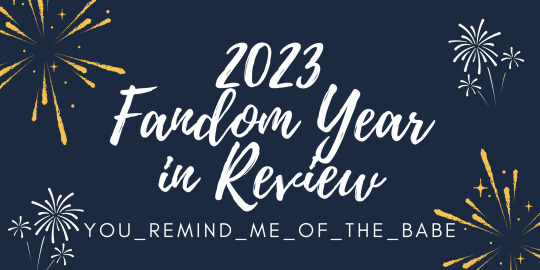
Another lovely year in this wonderful fandom. Here’s a little recap of how my year went:
My Writing:
Depth of Reason - Mature - 70k
How to Avoid a Scandal - Teen - 43k
Episode 3: The Diplomat, A Star Trek Redemption story - Teen - 13.5k
This list is much shorter than my list of fics written in 2022, but my fics last year were much shorter. Also, this word count is deceptive, because I wrote about 22k of Depth of Reason last year and about 20k of How to Avoid a Scandal last year as well. But! My writing goals this year were to finish these two WIPs and not take on any other projects until they were finished and I very nearly did that! Took on two projects (and more below), but I still finished these before the year finished, so pretty good!
Total words:
About 83k. Last year was more like 120k.
Other works:
Podfic of Petrichor - Teen - 34 minutes
Themes:
Finishing long works apparently! One was for my 2022 COBB and the other for my 2022 CORB. Even though these were started last year, they are the longest things I wrote since my first fic (49k) back in the second half of 2021.
Also, trying new things! Writing sci-if and recording a podfic felt very outside my wheelhouse at the time, but ultimately, I’m glad I went for it.
Top 10 fics I read in 2023:
Someone Wicked - Explicit - 60k by @artsyunderstudy
Three Months or 3,000 Miles - Gen - 3k by @larkral and art by @theimpossibledemon
Blood, Salt and Hummingbirds - Teen - 32k by @hushed-chorus
Restoration Ecology - The REmix (Baz’s version) - Explicit - 62k by @royalasstronaut
Good at Something - Explicit - 19k by @larkral
A Gift From the Propheseals - Mature - 6.5k by @skeedelvee with art by @letraspal
What Remains After the Storm - Mature - 86k by @hushed-chorus art by @erzbethluna
To Do, to Know, to Want - Mature - 8.5k by @facewithoutheart
Mishaps on Zoom - Explicit - 10k by @eelwinks
Swords Into Plowshares - Teen - 6.5k by @ileadacharmedlife
WIPs I’m excited to keep reading in 2024:
I Knew A Boy, I Knew A Man - Teen, by @shrekgogurt
Hiding Out In The Open - Mature, by @cutestkilla
A Little Bit Deadly- Explicit, by @emeryhall
Basil Pitch’s Diary - Teen, by @bookish-bogwitch
Other notable fandom things:
I helped to run @carryon-reverse-bang again with @angelsfalling16 as well as helped to put on a new event this year, @caught-on-tape-fest with @cutestkilla and @sillyunicorn
I met up with fandom friends while on a trip this past summer. Making personalized friendship bracelets as gifts, doing fic readings and crafts, and putting on our own Lady Ruth style tea party were some of my fave moments <3
I did a book club style reread of some of my fave fics with friends. I hope we do a few more in 2024!
It’s safe to say I engaged with this fandom everyday of 2023. I might get quiet on the main Discord server or Tumblr, but I’m certain I read, reblogged, wrote, DMd or otherwise participated in some way, shape or form throughout the entirety of the year.
Goals for 2024:
Read more fic! This fandom has such a wealth of works, my TBR list is a mile long and isn’t organized. I’d like to formally rework my AO3 bookmarks to exclusively show recs and either utilize the Marked for Later function or make a spreadsheet or something to better organize a proper TBR list so i don’t lose track of what I want to read next. Currently, having a dozen tabs open on my phone and another dozen on my iPad doesn’t really work well. If anyone has a brilliant system you’d suggest, please enlighten me!
I also want to read all of my physical canon books this year. I’ve only ever listened to the audiobooks! I’m currently reading my anniversary edition of Fangirl. (I think this is the prettiest book I’ve ever owned.) Up next, the Fangirl Manga, followed by the trilogy and Snow for Christmas.
More fandom meet ups! Already planning for June…
I don’t have any writing plans currently, so we shall see if/what I decide to create. I have a few ideas rolling around in my head, but nothing I’ve felt urged to put down in words. I’m sure I’ll write something, I just don’t know what it’ll be yet.
#That’s a wrap!#Love being a part of this fandom#Y’all are wonderful#here’s to another great year!#fandom year in review
55 notes
·
View notes
Text
Dev Diary #1 (Oct 27, 2024) - It All Starts Here!
Hi! I'm Pixie, and I am currently in active development on a new large-scale, fully voice-acted & immersive Skyrim follower mod named Seraph!
I've decided to start up a regular Developer Diary (You Are Here) to share progress & roadmap the release as she gets further along! Also if you haven't already, join the Discord (link after the jump) to stay updated & involved or just to say hi 🩷
Here's some early development highlights so far:
✨️ For Seraph's custom follower framework, I've built a new & improved core framework that is much more effective, elegant, & efficient than the framework most follower mod authors start with, & one of the benefits of this is that it's much harder for external problematic mods like AFT to break her brain!
✨️ Seraph's character and story has been deeply developed already, & her personal quests will be expansive! Her main personal questline is currently planned to play out in four acts/chapters, with an optional fifth chapter for...
✨️ Romance 💖 Seraph will be romanceable (& marriageable) for certain types of player characters! Without saying anything spoiler-y, Seraph's romance is not frivolous, exploitative, or lazy (as is often the case with romance options in many mods out there), it is an important narrative aspect of her character, and adds to a story that plays out over the course of your adventures together. Romance is not the main focus of the mod, & is completely optional, though just as much time & care is being put into it as any other part of the mod.
✨️ Seraph has a complex Approval system that feels much like the companion approval in Baldur's Gate 3, which has already been built & implemented. Your choices will matter, what you say and do will affect your relationship & things can turn out very differently based on dialogue chosen, playstyle choices, and more.
✨️ Seraph is feature-rich, and full of customizable toggles, options, and mechanics that range from functional and helpful to ones that just make her feel alive and fully fleshed out as a character. She can spar with you, have discussions on books and lore topics, bail you out of prison (with potential Approval ramifications!), won't call you the Dragonborn if you don't want her to, and a lot more. She also has all of the customary bells & whistles like follow distance controls, lore-friendly summon ability, relax/sandbox behavior options, etc. Many of these features are already built & implemented, or in various stages of that process.
✨️ I've also been working closely with my fantastic 3D artist @legendaryfirewizard (the artist who created Redcap's custom helmet model & several of Xelzaz's custom models) on a visual centerpiece that I don't want to spoil just yet, but that is central to Seraph's story & makes her very unique from any other follower mod.
There's so much more I'm excited to share, but without spoiling too many of the character & backstory details juuuust yet, I hope this first Dev Diary can give a small idea of what I'm hoping to achieve with this follower.
I've learned so much over the past few years of creating mods, and I've grown so much as a creator and a person in that time. Seraph is my love letter to creating, to character writing, to fantasy and RPG's, and to The Elder Scrolls which starting with Morrowind inspired me to imagine characters and stories within the world of Tamriel and beyond.
If you've read this far, I hope you'll give Seraph a download when the eventual release happens. In the meantime, feel free to join the Discord - to keep up to date with the project as it progresses!
- Pixie 💖
(Mod author, Voice Actress)
#skyrim follower mods#skyrim companions#skyrim custom followers#skyrim cvf#skyrim modded followers#skyrim mod followers#skyrim mods#skyrim modding#skyrim follower mod#skyrim follower#skyrim followers#skyrim cvfs#seraph#redcap#xelzaz#skyrim#tes#tes v skyrim#tesblr#the elder scrolls skyrim#voice acting#mods#dev diary#game dev blog#game dev
15 notes
·
View notes
Text
On Heteromorphs & Heteromorphobia (Arcs VI - X , Hero Killer to Provisional License Exam)
(This post will also cover the bonus chapter “Tsuyu's Ribbity Diary.”)
Thank you all for your amazing response to last week's post, my goodness! I thought I'd found about all the audience I was likely to get for my harping about heteromorphic discrimination, so I was delighted to see a number of new names!
I do have to warn you all, if you haven't done much looking into my archives, that I'm pretty critical of BNHA these days, especially of the ways it insists on holding up individualistic solutions to problems clearly established as systemic in nature. That will become more apparent when I get into the post-war material, as the endgame is absolutely rotten with it.
This week, though, we'll start by getting out of the school to get a look at signs of and contributors to heteromorphobia in the wider world.
The Vs. Hero Killer Arc (Chapters 45-59)
Chapter 45:
Mina’s preferred alias, Alien Queen, in reference to the Xenomorph queen from the Aliens franchise, is turned down by Midnight. The reason for this is never made especially clear. Class 1-B gets away with a number of villainous or monstrous hero names, like Phantom Thief and Gevaudan, violent ones like Battle Fist, even an animal reference in Jack Mantis. But Mina, for whatever reason, gets pushed towards the indescribably twee Pinky instead. Does Midnight the R-rated hero not think girls should get to have hero names with some edge? Surely not; her entire persona is based on titillation. Length is clearly not a factor, given that Midnight personally approves Can’t Stop Twinkling. I don’t know exactly what went down here (from a Watsonian perspective, that is; the Doylist guesses are readily apparent and all eyeroll-inducing), so I will simply point out that a non-baseline gal wanted to name herself after a famous monster with acidic blood and was pressured into going with something cutesy based on her skin color instead. Bakugou’s choice gets turned down as well,[1] but he actually has “murder,” like, right there in the name; Alien Queen is quite roundabout by comparison!
Chapter 48:
Introduction of Uwabami, the Pro Hero gal with the head snakes. She’s a bit of a weird case. Given that all we know she does is find hidden people using the snakes’ keen senses, do they have some self-awareness that makes them able to communicate with her—a case somewhat like Tokoyami and Dark Shadow, perhaps? Does she just tap into their senses at will rather than being able to speak to them? Or are they rather just extensions of herself, with no particular consciousness of their own, and they function like what must be a fairly dizzying array of extra-sensory perception that she receives at all times? Whatever the case, she’s a model and celebrity, and thus our first clear example of a heteromorph who doesn’t seem to suffer for her looks. Her looks are, of course, quite accentuated, given that her hero costume is a low-cut evening dress with a slit in the side up to her hip. Other than the hair-serpents, she’s a baseline woman who checks all the boxes for modern beauty standards; she will serve in this fashion as a good predictor of other highly ranked heteromorphic Heroes.
Chapter 51+55:
Endeavor, as will be made clear in Chapter 55, doesn’t really have any idea what the Noumu’s deal is. As far as he knows, it’s just like any other villain—and yet in Chapter 51, he opens up with an attack that bathes the Noumu in flame anyway, and comments in 55 that he’s never known anyone to remain conscious after such an attack. While I think this mostly speaks to the general brutality with which villains are treated by heroes—much different from standard police practice in real-life Japan!—it’s nonetheless notable that the Noumu he attacked with such casual ferocity certainly doesn’t look very baseline to the casual eye, between the exposed brain, the significant height, and the crawling movement.
Chapter 56:
Midoriya is startled by Chief Tsuragamae’s “woof” interjections. He doesn’t comment on it out loud, so I’m not inclined to hold it against him (not like someone else I’m about to bring up), but it wouldn't be the first time he’s come across this kind of vocalization: Tsuyu makes ribbit noises pretty frequently.
Tsuragamae notes that the authorization of a certain class of people, called “heroes,” to weaponize their quirks against others was initially a heavily criticized decision, one which only garnered public support because those original heroes were careful to always obey the laws dictating the circumstances in which they used their quirks. He goes on to say, of using one’s quirk to inflict harm without explicit instruction from the powers-that-be, “Such action would represent a stunning breach of law.” Like Thirteen before him, he completely omits any mention of how such laws disproportionately affect heteromorphs, who can’t turn off a permanent physical trait, and, particularly in cases of people whose entire bodies are divergent, have little choice in whether or not to use their quirk in any sort of physical altercation that might lead to harm.
Shouto, angry over what he perceives as punishment for a good deed, calls Tsuragamae a mutt. The chief doesn’t react particularly strongly to this, but as the chief of police, you have to imagine he’s pretty used to the slings and arrows of public opinion. The incident passes without comment, but it will not be the last time we hear a Todoroki derisively referring to another human being as an animal.
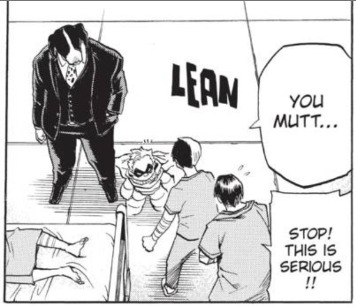
There are some sweatdrops and exhortations to get the kid to cool it, but those were ongoing before the animal words came out.
Chapter 57:
Gran Torino notes that the age they live in, for better or for worse, is one of suppression, and that the situation with Stain and the League will draw people out who are influenced by that ideology. Gran doesn’t elaborate on exactly what sorts of people he has in mind—All Might says only, “Then heroes will deal with them,”—but it’s an early hint that there are people in this society who feel unjustly suppressed. Crucially, Gran Torino doesn’t even necessarily think those people are wrong; he just thinks it’s a necessary evil. But what, exactly, is it that he’s grudgingly accepting as inevitable for the sake of maintaining the status quo? And how might his circumstances need to differ for him to have a different opinion?
In Chapter 27, we learned that producing support goods requires a government license; here we find out, courtesy of Giran, that dealing in and producing support goods without such a license is a major crime. So if you, for any reason, failed that “rigorous examination” to get cleared for support goods for quality-of-life reasons, you’re unlikely to find someone who’ll just provide them to you out of sympathy provided you keep quiet about where you got them. Instead, you have little choice but to turn to black market brokers—all because the government doesn’t think your quirk is affecting you negatively enough to qualify you for support equipment. Again, this isn’t specifically about heteromorphs, but someone having an emitter quirk they can’t control well who needs the support item because they are choosing to pursue a career requiring them to learn that control is a very different case than someone who needs government support because of an immutable, always-on physical trait.
This chapter contains the first appearances of both Gigantomachia and Spinner, both fairly extreme heteromorphs: Machia for his size and rocky hide, and Spinner for animal traits considerably more prominent than e.g. Tokoyami’s bird head or even Tsuyu’s conglomeration of mildly froggy traits. Indeed, Spinner’s heteromorphic traits are so much more prominent than something like Jirou’s earlobes that it hardly seems accurate to even categorize their bodies the same way.
The sidebar for Daikaku Miyagi, the anchorman with the quirk that gave him two big horns who amputated one so that it would be less in the way during newscasts and other things that required there to be a camera on him. This in and of itself wouldn’t necessarily be notable, save that the same extra goes on to describe how the decision garnered some backlash from “a certain human rights group” who said that decisions like his fostered discrimination and were linked to the rejection of quirk-based society on the whole. Horikoshi further notes that he enjoys thinking about the lives and stories behind minor characters—even this far back, then, three and a half years before the introduction of the CRC, we have concrete evidence that the author was thinking about quirk-based discrimination and the politicization of heteromorphic features.
Chapter 59:
All Might drops some exposition about the Advent of the Exceptional, during which we see an image of a crowd full of implied-quirkless people holding up signs proclaiming their humanity and the monstrosity of those with quirks. Conversely, three of the four quirked people we see have obvious physical divergence from baseline human appearance. So from early on, that “monster” turn of phrase was heavily associated with changes in the physical appearances of those with special abilities. Later on, the PLF advisor at the hospital will tie these two things together explicitly.
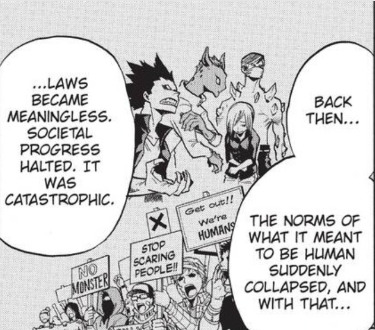
The Final Exams Arc (Chapters 60-69)
Chapter 61:
Ectoplasm’s character sheet. The teeth are creepy no matter which way you cut it, but they look much more profoundly unsettling when they’re right there on his unmasked face, as opposed to behind a black cowl, where you can let your eye fool you that they are in some way part of its design. His hero costume, naturally, includes the cowl, but his daily clothes do not—I wonder if he ever tried to have a gentle talk with Shouji about why Shouji wears the mask even in his downtime? I wonder even more how much the teaching staff in general, and Nedzu and Aizawa specifically, actually know about Shouji’s history. o It’s also noted that Ecloplasm looks scary, but has received continued support after coming back to the job after losing both legs in a fight with a villain—we see this same pattern with Jeanist after Kamino. No word on how regular his support was before the traumatic double limb loss, though.
Chapter 66:
Nedzu, we find, was “toyed with by humans in all sorts of ways in the past.” Nothing we know about him suggests that he has any particular longevity, but his dynamic with Endeavor,[2] many chapters down the line, does suggest to me that he was at least on the staff when with Endeavor was at UA some thirty years ago. Thirty years is within the span of All Might’s career, well after society began to stabilize with the formalization of the Hero System. And yet, despite that, a sentient being, one with human—above human!—intelligence, was mistreated badly enough that he bears a grudge to this day. Nedzu is, again, not in precisely the same situation as a human heteromorph, but he serves as an indicator of what humans have, even in the age of heroes, been willing to do to those they think of as “animals.”
A shot of Koda and his mother, who look much alike. Interestingly, the biggest difference in their appearance is that she has horn-like protrusions that her son lacks. We’re a long way from the first quirk evolutions, and even farther from Koda’s quirk evolution, but we will later see Koda’s mother specifically tie those horns to her animal communication quirk becoming more powerful. This makes for another good piece of evidence towards Horikoshi having a grasp of heteromorphobia from early on, as the evidence is pretty good that Koda-mama got those horns as a result of a quirk evolution of her own, and those don’t happen under normal, non-stressful circumstances. More on Koda’s parents in a bit, as they're a pretty stand-out case in another way that isn’t immediately apparent here.
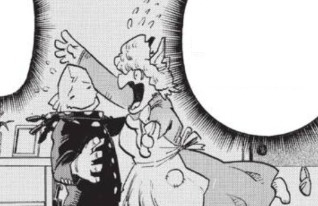
Can we call it foreshadowing for Koda defending Shouji at the hospital that Koda is wearing the same scarf as the main character in Horikoshi's Oumagadoki Zoo? Hmm. I'll leave that one to codenamesazanka.
Chapter 67:
A flashback panel to Mineta’s days in middle school. While I don’t doubt that there are P L E N T Y of reasons Mineta would be unpopular with the girls in his class, it is nonetheless notable that the popular boy getting showered with attention is perfectly baseline, while Mineta and his friends are not.
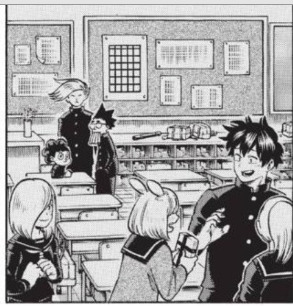
Note also that the cute heteromorph girl has long-ish ears and no other obvious divergent features.
Chapter 68:
Shouji and Iida are specifically called out to at the mall, trying to attract them as customers with claims that whichever storefront employee is hailing them can help them find anything they need. Midoriya mutters to himself about the difficulties of catering to everyone, given the many different types of quirks scattered across multiple age groups.
Crowd scenes at the mall show scattered numbers of heteromorphs, a somewhat higher number than usual for such civilian crowd scenes. The Kiyashi Ward Shopping Mall is noted for being the biggest and trendiest in the prefecture, with a variety that attracts lots and lots of people, so perhaps it’s no surprise to see somewhat more heteromorphs than usual there.
The Forest Training Camp Arc (Chapters 70-83)
Chapter 70:
Introduction of the Wild Wild Pussycats. A team of three Emitters and a Transformation-type, none of them in the slightest heteromorphic (give or take Tiger’s permanent :3 mouth), they nonetheless theme themselves after cats, including fake tails, big costume paw gloves, and cat-ear-esque headsets. It’s cute and unobjectionable in and of itself, but I do wonder what people like e.g. Officer Sansa think of it.
Chapter 71:
Shouji is missing from the hot springs scene. It doesn’t hugely stand out in the moment because Aoyama and Sero aren’t there either, but it does read a bit differently with the benefit of hindsight. Given the strong possibility that Aoyama is off doing Traitor Activities and Shouji is avoiding any possibility of having to torpedo the hot springs fun-times with an explanation of that time he was savagely beaten by people in his hometown right in an open street, it kinda leaves Sero as the only one who maybe just skipped for normal reasons, like that hot springs would gunk up his tape or something.
Chapter 73:
Bakugou addresses Ojiro as “Tail”—referring to him by his heteromorphic trait. He’s not even particularly angry at the moment; he’s just still nursing a grudge about Todoroki’s underwhelming performance in their Sports Festival match and wants to swap partners for the Test of Courage. Early Bakugou is very much a “judge a person by their quirk” sort.
Pixie Bob ushers Tsuyu and Ochaco into the woods for their turn at the Test of Courage by referring to the latter as Uraraka-kitty and the former as Ribbit-kitty.[3] While in the English, this reads as a baseline woman in a cat costume referring to the heteromorphic student by her animal-themed verbal tic and the baseline student by her actual name, uraraka is a fairly onomatopoeic way to say bright and cheerful. I would guess that Pixie Bob is probably referring to Ochaco’s personality here, which makes it somewhat less egregious. It won’t be the last time someone refers to Tsuyu via the frog sound instead of her name, though.
Chapter 75:
Mandalay telepathically compliments Spinner, calling him both cool and handsome. While I doubt he’s the only person in the world who’d react the way he does—he blushes, gets flustered, and missteps, giving Mandalay an opportunity to attack him—the moment does get some new context when you consider how everyone called him “the lizard freak” in his hometown. Approximately zero people calling him cool and handsome back there, one imagines! Having it immediately turn out to be a ploy likely informs some of the outraged anger in his response.
Chapter 81:
Mandalay points out that Spinner never used his quirk during their combat, implying that she doesn’t think just his lizard-like appearance or his claws “count.” Chalk another one up to the classification problems of “heteromorph” as a descriptive term. This will turn out to rather neatly illustrate one of the issues I’ve been talking about with regard to the way heteromorphs are unfairly disadvantaged by the current laws about public quirk use. Remember, a “Villain” is someone using their quirk illegally. So if Mandalay doesn’t think Spinner used a quirk here, and since he has no record, why does he get categorized as a Villain instead of just a garden variety criminal? Now, one could say that by associating with the League of Villains, Spinner is rather claiming the designation for himself, and we don’t know how the legal system will technically classify him, when and if he ever actually faces trial. To that, I would say to hold the thought, because Skeptic will eventually back me up on the, “Heteromorphs are unfairly targeted by Villain designations,” claim all but word for word.
BONUS CHAPTER 1: Tsuyu’s Ribbety Diary
We meet Tsuyu’s family, all various froggy types. They’re a cute family, but the husband and wife both being froggy kind of raises some questions about pressures that might exist about marrying your same “type,” or at least refraining from marrying anyone too obviously not. I’d be more willing to wave it off if not for two things. First, we get the same sort of scenario from Spinner’s character sheet, that his is “a family full of reptilian quirks.” Second, there are very few romances in the series between someone close to “baseline” and someone with a more extreme heteromorphic appearance. The most obvious, clear-cut, canonical example is Koda’s parents—his dad has slightly weird hair but is otherwise entirely baseline; we see him defending his wife from other peoples’ mockery. That, of course, is a single panel limited to a flashback inside a flashback, so not exactly very visible to the reader! The next-most significant one I can come up with is Natsuo and his mouse girlfriend, who has likewise been seen in one (1) panel, had no dialogue, and whose appearance and identity were so incidental the anime deleted her entirely. Who’s next? Well, if you assume all those No Comments from Kamui Woods and Mount Lady about their relationship are indicative of a relationship between them, they’d be another, though we don’t actually know what Shinji actually looks like under his mask, only the implication that it’s divergent enough that he prefers to cover his face. Next up on my tally would be Thief Takami and Tomie, but since the sum total of Takami’s animal traits are tiny little elbow wings, you can see how fast the drop-off is there. Compare this to the number of pairings/families we have between people of like type: Bakugou’s parents, Iida’s, Jirou’s, Aoyama’s, Tsuyu’s, Ochaco’s, Shouto’s, Toga’s, Spinner’s, and Tomura’s whole family on both sides. Then you get the ship-teasy stuff that’s more about crushes, people dating, or hints that are perceived as pointing towards epilogue romances: Deku and Ochaco, Jirou and Kaminari, Shindo and Yo, Gentle and La Brava, Miss Joke’s flirting with Aizawa, and Toga’s variety of crushes (among which Tsuyu is the most distant from Toga’s own body type).[4] I think Kirishima and Mina are right on that borderline, with Mina having a normal body type but a collection of minor but highly visible divergent traits. So like, the vast, vast majority of the romantic relationships in the show are between relatively baseline people. In that context, it sticks out like a sore thumb to me that Tsuyu and Spinner are both explicitly said to have the same type of animal heteromorph quality on both sides of their family tree. It’s not an incest concern or anything, just that I wonder what the pressure is on cross-type couples, or what social circles look like post-graduation.
Two classmates talk about how it’s hard to tell what Tsuyu is thinking; one of them says, with her eyes hooded and a kind of cool expression, “That expression of hers never changes. Maybe ‘cuz she’s a frog?”
Tsuyu tells us that she never really made any friends; while some of this may simply be because Tsuyu didn’t have much time to socialize, between hero training and looking after her family, it’s also true that all of her classmates that we see have baseline appearances.
This lasts until she starts getting stalked by a snake-headed heteromorph girl named Mangusu Habuko—a fellow loner. Tsuyu is initially frightened by Habuko’s behavior, but has an intuitive sense for what the deal is, that Habuko wants to be friends but is awkward and doesn’t know how to broach it.
When asked if she wants to be friends, Habuko flips out. She calls herself treacherous and untrustworthy; she calls Tsuyu a foolish frog and says she must be joking, and that she should choose her friends more carefully. She then immediately dissolves into tears. Somehow, I doubt all this self-loathing about her innate nature manifested out of thin air!
The Hideout Raid Arc (Chapters 84-97)
Something that’s observable throughout this arc is that we’re in another sequence, like the Sports Festival, where the percentage of people with heteromorphic features in the crowd shots tends to run a bit higher than the norm of the series to date. Unlike the Sports Festival, though, these crowds are just civilians, not heroes. So what’s the difference between Kamino and the earlier on-the-street crowd scenes? Well, the neighborhood the Noumu warehouse is in is a somewhat rougher area. Part of the visual shorthand for that is people in edgier clothes, stuff that’s indicative of districts with bars, clubs, sleazy hangout spots, and so forth, but another shorthand is an increased number of heteromorphs.
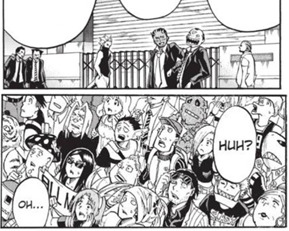
These panels are respectively from Chapters 87 and 92.
Chapter 87:
The character sheet for Kamui Woods notes that the story of his early childhood is “grand and compelling,” and that his story was made into a documentary. That, to me, has Inspiring True Story written all over it. Probably not coincidentally, Kamui Woods is another character whose face we’ve never seen. As more pointing in the direction of him having a childhood marked by severe discrimination, he’s not sure of his age—it’s given as “29 since he started counting.” So was he abandoned as an infant for his weird face? I could come up with other explanations, all equally over the top (extreme confinement, for example, that left him unable to properly mark the passage of time), but the fact that he can’t e.g. look up a birth certificate for himself suggests that whatever went so wrong for him, it happened very early. …Though I suppose there’s the possibility that he’s not human, but rather a tree that manifested a quirk. As documentary-worthy origins go, though, that feels less Inspiring True Story and more Educational Biopic About Rare Phenomenon.
The Provisional Hero License Exam Arc (Chapters 98-121)
Chapter 99:
Shouji’s room is shown, all but barren. He says that he doesn’t care much about owning things, but knowing what we come to know about his history, it’s easy to wonder if he really doesn’t care about owning things or if this is rooted in a childhood in which it was believed that anything he touched would be polluted. Not a situation that led to him being given much of his own, one suspects!
Chapter 103:
This chapter introduces Yokumiru Mera, from the HPSC, who gives an opening statement that has some very interesting ruthlessness lurking in its subtext. Particularly relevant to our current topic is his comment that in the modern era, the time it takes to resolve a given incident is incredibly short, so the test that year will be prioritizing speed. Prioritizing speed (wouldn’t want some other hero to get the metaphorical kill first, after all!) is a surefire way to guarantee that heroes are not taking the time to really examine all factors in a situation or make any attempts whatsoever at calm, considered de-escalation, but rather are just making snap judgements based on their biases and gut reactions. Guess what group of people that’s going to disproportionately impact? o Now, it’s notable that Mera says the test prioritizes speed, but the conclusion many others come to is that the test only pretends to do so; that actually, it prioritizes care and information gathering. Indeed, we find a few chapters later that the actual priority is teamwork, as requested by police higher-ups—the idea is to fill in the gap left behind by All Might with hero squads that work well together.[5] However, while the intention may be to gather those good at teamwork, it certainly doesn’t stop people like Shouto and Inasa from cruising through—and, in any case, whether the groups learn teamwork or not doesn’t take away from an HPSC rep telling them to their face that speed of incident resolution is one of the most important things to a modern hero and never following that up with any kind of amendment or clarification.
Chapter 107:
Introduces the HUC, or Help Us Company, professionals trained to act as victims in disaster rescue exercises. Given that context—what they’re communicating to students training to understand what “victims” look and act like—it’s extremely worth examining what they, well, look like.
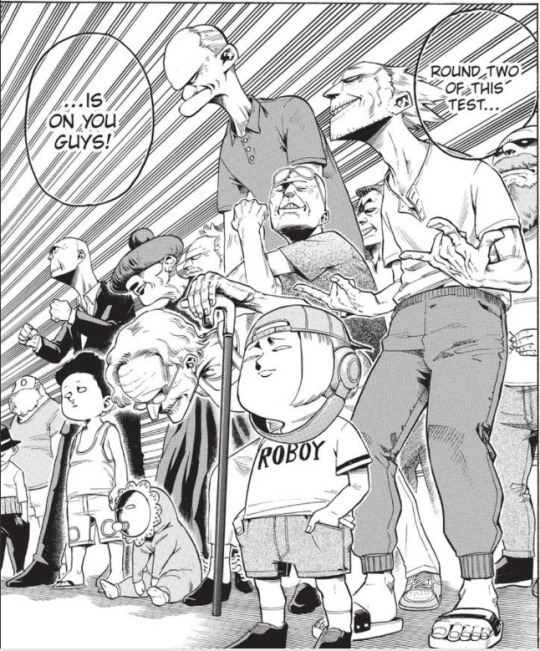
God, this is so Yikes.
And having asked that question, we find that the only people in this group that might not be baseline—the ones with short, childlike statures—are dressed to emphasize that stature. The end effect is a crowd of “victims” with not a single heteromorphic representative.
Chapter 109:
Shiketsu’s class rep, Mora Nagamasa—the extremely hairy one—approaches Bakugou to extend an apology for Shishikura’s behavior during the exam. It’s noticeable here that, having matured somewhat since Early Series Bakugou, and having been approached in downtime in a reasonable manner, Bakugou manages to refrain from coming up with any demeaning nicknames centered on Mora’s appearance. Kirishima remarks internally on all the hair, but only internally; he’s much too polite to say anything out loud.
Chapter 110:
A big splashy introduction for the man ranked #3 in the Heroes Who Look Like Villains ranking, Gang Orca. He’s at the test to play villain and is, just as noticeably as all the play-victims are baseline, a heteromorph. At the time of his introduction, he’s ranked Number 10 in the Hero Rankings, but will be bumped out later on. This does, however, make him the highest-ranked known heteromorph who doesn’t have a human face,[6] with the possible exception of Kamui Woods—who, like Shouji, covers it with a mask.
Gang Orca’s character sheet notes that, while he’s a popular guest at aquariums, his intimidating face and “stony personality” always result in weepy children. He apparently finds this relatively upsetting (“lots of angst”) but, unlike Shouji or Kamui Woods, has not taken to wearing a mask, nor trying to tone down his personality on any level—to the contrary, Present Mic suggests much later on that he exaggerates it.
-----------------
Next time, I'll cover from the Shie Hassaikai arc through the end of Joint Training. Thanks for reading!
--------------------- FOOTNOTES ---------------------
[1] Initially. He sticks to his guns long enough that he gets away with it in the end, though.
[2] The big tell is that Nedzu addresses Endeavor as Todoroki-kun rather than Todoroki-san or simply by his hero name, but his observation that Todoroki-kun has “matured” (literally in the Japanese, “become an adult”) doesn’t hurt, either.
[3] Kerokero neko and Uraraka neko.
[4] You can get further out there with this, but by the time you get to e.g. Shouto and Momo or Ojiro and Hagakure, the ice is definitely getting thinner on whether you’re seeing groundwork for future wedding bells or just reasonably close male/female friendship. Your mileage may vary depending on how tightly attached your shipping goggles are or how cynical you are about shounen authors’ tendencies towards timeskip marriages. Also, I can’t be bothered to dig up and list out the crushes or shipping patterns among the Class B kids. Koroiro likes the mushroom gal?
[5] Note that Mera phrases this as being merely a stopgap until they find the next All Might. The HPSC is not so eager to change the methods they’ve come to rely on over the last thirty some-odd years!
[6] We don’t know enough for me to say for sure whether Wash is a heteromorph.
#bnha#heteromorph discrimination plot#my writing#bnha meta#bnha worldbuilding#huc for no. 1 group that needs to have mandated diversity hires#seriously there needs to be a lawsuit or something#where's that “certain human rights group” when you need them
81 notes
·
View notes
Text
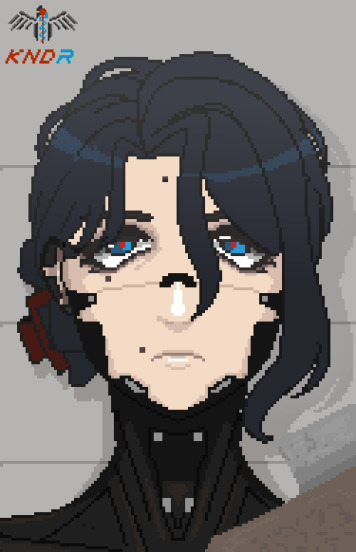
erm wat the scallop
i worked too hard for this
meet the Kondors! who are, TOTALLY just not a recycled oc for fun
lore will b under a spoiler so it doesnt look too long
Condors are known to be always watching with careful eyes, observing the area to scavenge for carcasses to consume intermittently. They are part of nature's recycling system by eating leftover waste by other predators.
REPLIKA OVERVIEW:

Katastrophenabwehr-, Nachrüster und Demontierer- Replika
- 'Kondor' - (Disaster Response, Retrofitter and Dismantler Replika, Condor) Type: Generation 5 General Surgeon Replikas Frame: Biomechanical with Polyethylene Shell Height: 170 cm
These units are doctors, particularly surgeons; specialized for intense care for gestalts and maintenance of other replikas, as well as dismantling replikas and disposing deceased gestalts.
KNDR Units are the maintenance crew and healers of replikas and gestalts. These are worker units working diligently and meticulously to maintain the health of the Nation's people and keep the Nation's replikas functional. Fitted with nimble, flexible hands and arms; they are designed to reach into nooks and crannies within a humanoid body to reach hard places. KNDRs are specialized in both gestalt and replika anatomy, however they NOT are fit for combat. KNDRs are mainly stoic and professional, social enough to be presentable to patients but not as excitable as the EULR units.
REPLIKA KNOWN ISSUES:
Kondors are made to work in hospitals as doctors and surgeons, however they are often stiff and lack sensitivity, thus must work with at least one Eule unit to not spook, offend, or have trouble with gestalt patients. They should not be disturbed whilst on the clock as disrupting their schedule or cycle leaves Kondors frustrated and degrade. They should not be given or shown anything related to birds, particularly eagles, whether images, stuffed toys, and other fetish items made in its image. They should not be given any photographs or mentions of forest rangers, should not be given firearms, and avoid interacting with animals to avoid gestalt memories from resurfacing.
Kondors are given fetish items, made to write in diaries and calming activities for persona stabilization such as cooking, sewing, a stuffed toy so long as it is not an eagle of any kind.
Kondors should be observed while interacting with young gestalts, (i.e children) under the supervision of a senior Eule unit. Although it is great for maintaining persona stabilization, it may also lead to Gestalt memories to resurface should Kondors get attached to children and treat them as their own, and must be immediately separated or decommissioned to prevent further persona degradation.
STOLEN DOCUMENT:
-CLASSIFIED INFORMATION-COMMANDER EYES ONLY-
KNDR units are based off the late gestalt, Reese Jakobsen's neural pattern. A long deceased professor of animal and human biology. Most of her gestalt memories are wiped to enhance the surgical capabilities of the replika. However the gestalt's grief over her lost daughter is a long pesky hurdle into making the Kondors reach its maximum efficiency, as they often struggle dealing with young gestalt patients ages from 1-15 years old.
It should be suggested that they do not interact with children, and should instead leave questions and routine checkups, inspections, to the Eules. Or if unable to do so, at least have one or two more other replikas within the room to guide the Kondor and maintain professionalism to avoid persona degradation. They should be immediately decommissioned should persona degradation start, it is not advised to risk maintaining a failing unit with reduced efficiency due to degradation.
61 notes
·
View notes
Text

Health and Fitness: Tips and Benefits
Health and fitness are two interrelated concepts that affect our well-being and quality of life. Being healthy means having a good physical and mental condition, free from diseases and disorders. Being fit means having the ability to perform physical activities with ease, strength, and endurance. Both health and fitness can be improved by following some simple tips and enjoying some benefits.
Tips for Health and Fitness
One of the most important tips for health and fitness is to exercise daily for at least an hour. Exercise can help you burn calories, strengthen your muscles, improve your cardiovascular system, and boost your mood. You can choose any type of exercise that suits your preferences and goals, such as walking, running, cycling, swimming, dancing, or lifting weights. The key is to be consistent and challenge yourself gradually.
Another tip for health and fitness is to eat the right foods and portion each meal. Eating a balanced diet that includes fruits, vegetables, whole grains, lean proteins, healthy fats, and water can provide you with the nutrients you need to function properly and prevent diseases. You should also avoid or limit foods that are high in sugar, salt, saturated fat, and processed ingredients. Additionally, you should control your portion sizes and avoid overeating or skipping meals.
A third tip for health and fitness is to keep track of calories and food intake per day. Knowing how many calories you consume, and burn can help you balance your energy intake and expenditure. This can help you maintain a healthy weight or lose weight if needed. You can use a food diary, an app, or a website to record what you eat and drink every day. You can also use a calorie calculator to estimate how many calories you need based on your age, gender, height, weight, and activity level.
A fourth tip for health and fitness is to be sure to get enough sleep. Sleep is essential for your body and mind to recover from the day’s activities and prepare for the next one. Sleep can also affect your appetite, metabolism, immune system, mood, memory, and concentration. You should aim to get at least seven to nine hours of quality sleep every night. To improve your sleep hygiene, you should follow a regular sleep schedule, avoid caffeine, alcohol, nicotine, and screens before bed, create a comfortable and dark sleeping environment, and relax before sleeping.
A fifth tip for health and fitness is to stay motivated. Motivation is the driving force that keeps you going despite the challenges and obstacles you may face. To stay motivated, you should set realistic and specific goals, track your progress, celebrate your achievements, reward yourself, seek support from others, join a group or a class, find a workout buddy, or hire a personal trainer. You should also remind yourself of the reasons why you want to be healthy and fit.
Benefits of Health and Fitness
Health and fitness have many benefits for your physical and mental well-being. Some of the benefits are:
Reduced risk of chronic diseases: Being healthy and fit can lower your chances of developing conditions such as heart disease, stroke, diabetes, cancer, osteoporosis, arthritis, and obesity.
Improved balance and coordination: Being fit can enhance your ability to maintain your posture, move gracefully, avoid falls and injuries.
Increased energy levels: Being healthy can boost your metabolism and provide you with more fuel to perform your daily tasks.
Enhanced mood: Being fit can release endorphins in your brain that make you feel happy. Being healthy can also reduce stress hormones that cause anxiety.
Better self-esteem: Being healthy and fit can improve your appearance, confidence, and self-respect.
Conclusion
Health and fitness are important aspects of our lives that we should not neglect. By following some simple tips such as exercising daily, eating right, tracking calories, getting enough sleep, and staying motivated, we can improve our health and fitness levels. By doing so, we can enjoy many benefits such as reduced risk of chronic diseases, improved balance and coordination, increased energy levels, enhanced mood, and better self-esteem. Health and fitness are not only good for us but also for those around us who care about us. So, let’s start today!
#health & fitness#health and wellness#health#nutrition#weight loss#diet#fitness#healthy living#exercise#healthy eating#healthy lifestyle#healthy food#healthy diet#wellness#health tips#healthcare#prevention#health is wealth
54 notes
·
View notes
Text
Dev Diary 15 - Mechanics Reworks
Hello cosmonauts! It’s been a minute.
So we finally finished Chariots of Steel and were all eager to turn development time over to Torchship when I got covid. I was too sick to do anything for a week, and then have spent the time since exhausted, coughing, and headache-y. I’m still coughing. What a cool sickness to have!
Because of that, I really haven’t made the progress I was hoping to, but I do have some things to talk about from the current draft of the game. So here goes…
Unity Rewrite
One of the problems revealed by last year’s Metatopia playtest was that players didn’t really have a good idea of how important Unity was supposed to be, because it was a simple uncapped resource. Like any such resource, either they ignored it, or it activated the player’s hoarding instincts and they stockpiled it and dedicated themselves to whatever roleplay triggers would get more without ever spending it.
Uh, oops, should have seen that coming.
So one of the biggest changes in the current drafts is that Unity has gone from being a pool of resources to being a bar you try to keep topped up, like so:

So long as you stay in the green ‘United’ range of 10-12, you have a free 1d6 reroll on all your dice pools. While not a hugely powerful buff, it’s a passive benefit that helps no matter what you’re doing, so you always want it if you can. There’s no benefit or drawback to being at Functional, but Tense and Fracturing hit you with escalating penalties.
This tells players when they need to be looking to form or act on relationships for the Unity benefits. Your Unity falling (through complications on rolls, stress in combat, or relationship complications) acts as an invitation to groups to get more involved, to declare relationships with each other and the various sides of a debate, and possibly act irrationally on them.
This incentive structure also heightens the political metaphor of the relationship system and the way it will affect your interaction with groups. When things are fraying in your in-group, the fastest way to rebuild cohesion is to find an out-group, to stop being impartial and take sides. As circumstances change, you might find yourself dealing with the sunk-cost fallacy of having backed a horse you no longer believe in, faced with the reality of risking your group’s Unity to make the right choice, and the potential danger of swinging too far the other way as you try to rebuild cohesion.
Damage Rework - Conditions
Another massive change in the Alpha is a totally reworked system for damage, creating a single universal framework for everything from personal injury to wear and tear on tools to massive impact on spacecraft.
When something is damaged, that damage gets converted by the GM into Conditions. A Condition consists of a narrative description and a severity between 1-6; the severity determines the degree of penalty taken when the narrative of the condition becomes relevant (with 6 Damage indicating something has been destroyed outright and can’t be used). Damage is converted to Severity 1-1, so if you take more than 6 damage, multiple Conditions will arise.
This system can be used for anything, and focuses on creating problems that you have to work around and solve (you know the thing this kind of sci-fi is all about). If you get shot in the arm, having to figure out how to do things one-handed to avoid the penalty becomes an interesting problem you have to navigate around. If you drop your scanner down an elevator shaft by accident, you have to navigate your adventure with 1 Disadvantage on your sensor checks because of a cracked lens. And when 24 points of Thermal damage hits your spaceship from a laser hit, those become Conditions on your various modules and subsystems, realistically knocking out parts of your spacecraft so your engineer player gets to fix them and your medic gets to attend to crew.
This system also allows the GM to metre out the nature of damage to match the needs of the narrative much more easily. This allows weapons to be realistically dangerous without simply killing player characters all the time, because damage can be freely split between conditions; six damage from a handheld railgun doesn’t have to one-shot you, it can be interestingly split into a number of conditions describing the path of the shot.
It also heavily simplifies a number of the game’s Hazards; you can make an ‘oxygen deprivation’ condition or a ‘barotrauma’ condition or a ‘heat stroke’ condition just as easily as anything else, and Resistances can be applied to that damage the same way. It elegantly compresses a number of systems from earlier drafts into a single, solutions-first mechanic.
Modes of Play & Vignettes
One big change in the new Draft is how the game uses alternating modes of play. We’ve ended up settling on four, two ‘main’ modes and two modes which are like exaggerated versions. You constantly build up Strain through Activity and Alert, every time you roll dice or get hurt, and you remove that Strain by going into Reflection and spending Supply.

The way we’ve decided to do this so that Reflection & Resupply can be tracked and even applied retroactively is Vignettes. Vignettes are scenes you play during Reflection to give a break from the action, creating the character moments that make us invested in the weird sci-fi shit by giving us a glimpse into the world. However, because each one is a discrete mechanical package with simple outcomes, you can also go ‘hey wait, I think that scene we just played was a Vignette!’ and it’ll still work.
The entire party plays the same Vignettes together and shares the benefits, with you playing more Vignettes the longer your characters are waiting (non-linearly; an hour gets you 1 Vignette, but a day only gets you 3). This timescale compression helps to get across the vast scale of space; there will be times when combat begins, both sides launch missiles at each other, and then you realise that it’ll be an hour before impact and you’re able to play a tense Vignette while you wait!
There are currently 9 Vignettes:
Three are Meetings: Conferences where you adjust your Investigation Checklists, Briefings where you make plans for dice bonuses, and Debates where you decide what to do in a controversial situation.
Three are Downtime: Relaxing to generate Unity and remove Strain, Lower Decks to introduce new crew NPCs you can call on for help, and Tourism to hang out with the locals, get language XP, and fill society checklists in a fun montage.
Three are Labour: Training to get XP, Treatment to recover Harm, and Project Work to create new Tools.
Resupply, which happens almost exclusively between episodes, will unlock three new Vignettes dedicated to your resources, spacecraft, and what’s happening back home.
That’s all for now. Hopefully we’ll have more detail for you next diary, which hopefully won’t take nearly as long. Provided there are no more tanks or awful diseases in my near future…
43 notes
·
View notes
Text
[“The belief that the troubling circumstances we have come to tolerate are impervious to change can itself become an excuse for resignation. It can fuel the kind of apathy that prevailed among the “passive democrats” that Everett Hughes described in his Frankfurt diary. The resignation is unwarranted, because, like most aspects of the social order, dirty work is not immutable. It is a function of laws and policies, of funding decisions, and of other collective choices we have made that reflect our values and priorities. Among these choices is whether to recognize the immense harm it causes, not only to innocent people and the environment but also to the people who carry it out.
The anguish such workers experience may elicit little sympathy from those who feel that anyone who participates in a cruel or violent system must be held accountable for the suffering they cause, even if, afterward, they harbor shame or regret about what they have done. As Primo Levi affirmed in “The Gray Zone,” doubts and discomfort expressed after the fact by oppressors are “not enough to enroll them among the victims.” But Levi also called for judgment of the low-ranking functionaries in oppressive systems to be tempered by awareness of how susceptible we all are to collaborating with power, and by an appreciation of the circumstances that lead relatively powerless people to be pushed into such roles. In contemporary America, the chief circumstance to consider, I have suggested, is inequality, which has shaped the delegation of dirty work no less than the distribution of wealth and income. More privileged Americans are spared from any involvement in such work, knowing it can be outsourced and allotted to people with fewer choices and opportunities. The result of this moral inequality is to ensure that an array of hidden injuries—stigma, shame, trauma, moral injury—are concentrated among those who are comparatively disadvantaged. These moral and emotional burdens have barely factored into the debate about inequality, perhaps because economists cannot measure and quantify them. But their effects can be equally pernicious and debilitating, shaping people’s sense of self-worth, their place in the social order, and their capacity to hold on to their dignity and pride.
Inequality also shapes the geography of dirty work and who is held responsible for it. As we’ve seen, the blame is rarely directed at the companies that profit from it or the public officials who have passed laws and policies that perpetuate it. More typically, it falls on the least powerful people in the system, “bad apples” who are singled out after the periodic “scandals” that shock the public—the same public that spent the preceding months or years ignoring what was being done.
In fairness, one can hardly expect the public to register concern about conditions it rarely sees. Dirty work is obscured by structural invisibility: the walls and barriers that keep what happens inside prisons and industrial slaughterhouses hidden; the secrecy that envelops the drone program; the nondisclosure agreements that the middlemen overseeing the cobalt supply chain are required to sign. These arrangements have had a “civilizing” effect, pushing disturbing events “behind the scenes of social life.” Yet there are limits to what even the most elaborate mechanisms of concealment can hide. In spite of the isolation and impenetrability of institutions like prisons and industrial slaughterhouses, plenty of information about what transpires within them leaks out. The secrecy cloaking the drone campaign has not stopped writers and documentary filmmakers from producing illuminating work about it, nor have nondisclosure agreements prevented NGOs from issuing detailed reports about the cobalt supply chain. The problem is not a dearth of information but the fact that many choose to avert their eyes, not only from dirty work but also from those who get stuck doing it, people with whom they almost never interact and find easy to judge.
What do we owe these workers?”]
eyal press, from dirty work: essential labor and the hidden toll of inequality in america, 2021
107 notes
·
View notes
Note
man ok idk if youll be able to advise on this or something but like. do you know anything regarding dealing with like internalised ableism?
i live in a rural part of ireland, right? and idk what it is about rural ireland but some of the people are heinous. my school is in a small miserable-ass town and like. God, man. not everyone sucks, of course but like. jesus lol additionally i have a ~mildly ableist~ mother (a "we're all a little bit autistic" and "erm. youre not disabled because youre not in a wheelchair or blind/deaf" etc etc type stuff. + "npd = bad person" which isnt particularly good for me specifically because i have npd (that i both Cant get an official diagnosis for, for various reasons, and im not really Looking for one either because i know what i am and its not like you get support for it because ~ooh scary narcissist~.)
and like. idk if this is Obvious but that can kinda cause a weird-ass relationship with You (being Me in this case, yk how it is with the second person perspective when. ranting) and The Concept Of Being Disabled. like, objectively. im disabled. im autistic, ive definitely got adhd (that im hopefully going to get examined for at some point cause college stuff requires it for the disability forums and stuff. gotta love that. fuckin 80% comorbidity right?), ive got a laughable number of repetative strain injuries, i have a sensory processing disorder, an endocrine disease that effects my Entire cardiovascular system, a spine that felt a lil quirky and bent in too much. so on a so forth
but also like. it feels wrong to call myself disabled. yk, like im doing a disservice to all the other ~actually~ disabled people (being Anyone but me lol) (none of this is At All helped by the fact that my mother refuses to listen to me regarding Jack Shit about my health in Any way. "oh you nearly passed out on top of a hill because of your cardiovascular condition? erm youre just not exercising enough actually" "you dont have depression [said while i was filling out an assigned mood diary after being forcefully brought to camhs for Reasons" like. shut the fuck up and Listen to me please. at least Entertain the idea that i could be right about something for fucking once lmao. cause ive been right about EVERYTHING regarding my mental health so fucking far so. fuck off /nay ofc) (also man. like, even if you ignored the physical issues ive got im still disabled on account of being autistic. like, motor function is fine, despite being a lil clumsy and/or unsteady sometimes but like. my emotional needs are Fucked. think of the response youd get if you asked a. fuckin. 8 year old or something to do algebra. but with a very emotionally stunted and traumatised 17 year old lol. lmao, even /lh)
so like. if youve got. any advice or whatever on any of this thatd be Super cool + no pressure obvs. sorry this is a whole. like. fucking essay's worth of Random Guy Complaining To You On The Internet lol
-🐢 <- just so i can find this again if you respond. i Like Turtles. i am Normal about the tmnt and also turtles The Creatures. i wont talk at length about turtle mutant anatomy (i am deceiving you)
Internalised ableism is a really hard thing to deal with, especially when you're surrounded by people who constantly re-enforce it. I've also spent a lot of time worrying that I'm not disabled 'enough' to deserve certain accommodations, that I'm making an unnecessary fuss. But the truth is, autism IS a disability and if there are accommodations that can help support you, you deserve access to them. You're not taking away from others with disabilities by advocating for yourself.
It's taken me a long time to understand this and I still worry sometimes. What has helped is talking about my experiences with people I know understand, like my therapist or best friend, and learning about the experiences of other autistic people through books, social media, YouTube and even real life.
I'm sorry your mother and others aren't being understanding - remember that's a them problem, not you, and try to spend your time with people who do understand.
🐢🐢🐢 <- the turtles wish you luck
#🐢#ask#anon ask#autism#actually autistic#advice#autistic#autism is a disability#its a spectrum#long post
35 notes
·
View notes